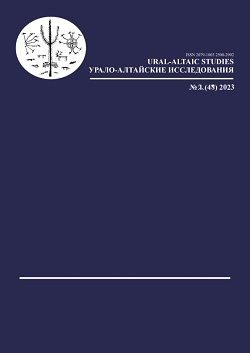К вопросу о событийной структуре морфологического каузатива: данные татышлинского говора удмуртского языка
On the Question of the Event Structure of the Morphological Causative: Tatyshly Udmurt Data
Author(s): Daria D. BelovaSubject(s): Morphology, Syntax, Finno-Ugrian studies
Published by: Институт языкознания Российской академии наук
Keywords: Udmurt language; morphological causative; event structure; direct and indirect causation;
Summary/Abstract: The paper deals with the event-structure properties of causative verbs with the suffix -t in Tatyshly Udmurt (Republic of Bashkortostan). Concerning external causatives, we consider the following phenomena that are sensitive to the event structure and are accepted in the literature as diagnostics of mono- or bi-eventive causatives: a set of possible controllers of the subject of the converb clause (only the Causer / the Causer and the Causee), modification by the manner, temporal localization, duration, and frequency adverbials (only the caused sub-event / the caused and the causing sub-events / the whole situation). Applying these diagnostics shows the following results. The test for the ability to control the subject of the converb clause is the only one of the entire battery that corresponds to the bi-eventive structure, which may be due to some external syntactic factors and thus casts doubt on the reliability of this test in other languages. The tests for the interpretation of adverbials show that the causing subevent cannot accept any modifiers and has an extremely reduced structure. Causatives with both contact and distant semantics are therefore single-eventive, which contradicts the known data of standard Udmurt. The results obtained speak in favor of approaching the semantics of causatives as a continuum between direct and indirect causation. Tatyshly Udmurt morphological causatives with the suffix -t cover the entire semantic continuum, except for the actual indirect ones, since even distant uses do not allow a temporal gap between the causing and the caused sub-events. The fact that situations of causation, which are conceptualized as single, indivisible situations, are expressed by morphologically productive rather than lexical means seems typologically curious.
Journal: Урало-алтайские исследования
- Issue Year: 2023
- Issue No: 02 (49)
- Page Range: 7-26
- Page Count: 20
- Language: Russian

